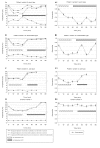Thermography imaging during static and controlled thermoregulation in complex regional pain syndrome type 1: diagnostic value and involvement of the central sympathetic system
- PMID: 16689997
- PMCID: PMC1479347
- DOI: 10.1186/1475-925X-5-30
Thermography imaging during static and controlled thermoregulation in complex regional pain syndrome type 1: diagnostic value and involvement of the central sympathetic system
Abstract
Background: Complex Regional Pain Syndrome type 1 (CRPS1) is a clinical diagnosis based on criteria describing symptoms of the disease. The main aim of the present study was to compare the sensitivity and specificity of calculation methods used to assess thermographic images (infrared imaging) obtained during temperature provocation. The secondary objective was to obtain information about the involvement of the sympathetic system in CRPS1.
Methods: We studied 12 patients in whom CRPS1 was diagnosed according to the criteria of Bruehl. High and low whole body cooling and warming induced and reduced sympathetic vasoconstrictor activity. The degree of vasoconstrictor activity in both hands was monitored using a videothermograph. The sensitivity and specificity of the calculation methods used to assess the thermographic images were calculated.
Results: The temperature difference between the hands in the CRPS patients increases significantly when the sympathetic system is provoked. At both the maximum and minimum vasoconstriction no significant differences were found in fingertip temperatures between both hands.
Conclusion: The majority of CRPS1 patients do not show maximal obtainable temperature differences between the involved and contralateral extremity at room temperature (static measurement). During cold and warm temperature challenges this temperature difference increases significantly. As a result a higher sensitivity and specificity could be achieved in the diagnosis of CRPS1. These findings suggest that the sympathetic efferent system is involved in CRPS1.
Figures




References
-
- Bruehl S, Harden RN, Galer BS, Saltz S, Bertram M, Backonja M, Gayles R, Rudin N, Bhugra MK, Stanton-Hicks M. External validation of IASP diagnostic criteria for Complex Regional Pain Syndrome and proposed research diagnostic criteria. International Association for the Study of Pain. Pain. 1999;81:147–154. doi: 10.1016/S0304-3959(99)00011-1. - DOI - PubMed
-
- Kent P, Wilkinson D, Parkin A, Kester RC. Comparing subjective and objective assessments of the severity of vibration induced white finger. J Biomed Eng. 1991;13:260–262. - PubMed
-
- Sherman RA, Karstetter KW, Damiano M, Evans CB. Stability of temperature asymmetries in reflex sympathetic dystrophy over time and changes in pain. Clin J Pain. 1994;10:71–77. - PubMed
Publication types
MeSH terms
LinkOut - more resources
Full Text Sources
Research Materials

